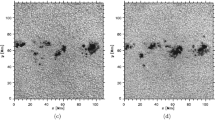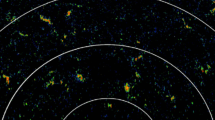Abstract
A number of processes associated with the formation of active regions produce ‘U-loops’: fluxtubes having two ends at the photosphere but otherwise still embedded in the convection zone. The mass trapped on the field lines of such loops makes them behave in a qualitative different way from the ‘omega-loops’ that form active regions. It is shown that U-loops will disperse though the convection zone and form a weak (down to a few gauss) field that covers a significant fraction of the solar surface. This field is tentatively identified with the inner-network fields observed at Kitt Peak and Big Bear. The process by which these fields escape through the surface is described; a remarkable property is that it can make active regions fields apparently disappear in situ. The mixed polarity moving magnetic features near sunspots are interpreted as a locally intense form of this disappearance by escape of U-loops.
Similar content being viewed by others
References
Acheson, D. J.: 1979, Proc. R. Soc. London Series A 289, 459.
Gaizauskas, V., Harvey, K. L., Harvey, J. W., and Zwaan, C.: 1983, Astrophys. J. 265, 1056.
Harvey, K. and Harvey, J. W.: 1973, Solar Phys. 28, 61.
Howard, R. and LaBonte, B. J.: 1981, Solar Phys. 74, 131.
Livingston, W. C. and Harvey, J. W.: 1975, Bull. Am. Astron. Soc. 7, 346.
Martin, 1987, presentation at the ‘Solar Cycle Workshop’, to be published.
Mosher, J.: 1977, ‘The Magnetic History of Solar Active Regions’, Ph.D. Thesis, California Institute of Technology.
Parker, E. N.: 1979, Cosmical Magnetic Fields, Clarendon, Oxford, Ch. 13.
Parker, E. N.: 1984, Astrophys. J. 281, 839.
Roberts, P. H.: 1967, An Introduction to Magnetohydrodynamics, American Elsevier, New York, Sect. 2.3.
Schüssler, M.: 1980, Nature 288, 150.
Sheeley, N. R., Jr.: 1969, Solar Phys. 9, 347.
Simon, G. W. and Wilson, P. R.: 1985, Astrophys. J. 295, 241.
Smithson, R. C.: 1975, Bull. Am. Astron. Soc. 7, 347.
Vrabec, D.: 1974, in R. G. Athay (ed.), Chromospheric Fine Structure, D. Reidel Publ. Co., Dordrecht, Holland, p. 201.
Wallenhorst, R. C. and Topka, K. P.: 1982, Solar Phys. 81, 33.
Wilson, P. R.: 1987, Solar Phys. 110, 59 (this issue).
Wilson, P. R. and Simon, G. W.: 1983, Astrophys. J. 273, 805.
Author information
Authors and Affiliations
Rights and permissions
About this article
Cite this article
Spruit, H.C., Title, A.M. & Van Ballegooijen, A.A. Is there a weak mixed polarity background field? Theoretical arguments. Sol Phys 110, 115–128 (1987). https://doi.org/10.1007/BF00148207
Issue Date:
DOI: https://doi.org/10.1007/BF00148207




